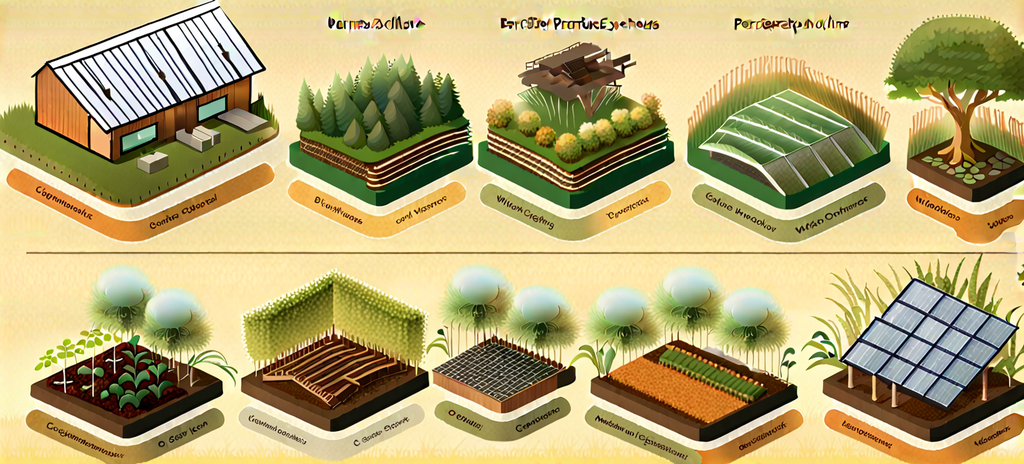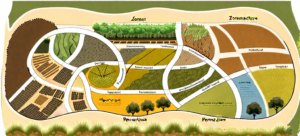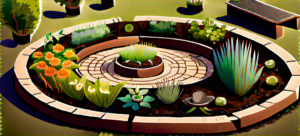Permaculture Design Concepts: Permaculture, an amalgamation of ‘permanent’ and ‘agriculture’, encapsulates an approach to agriculture that emphasizes sustainable and self-sufficient ecosystems. It embraces biodiversity, using patterns observed in natural ecosystems to establish productive environments that foster long-term ecological balance.
Importance of Permaculture Design Concepts
Underpinning the ethos of permaculture are design concepts, principles that steer the creation of sustainable human habitats. By marrying agricultural systems with ecological symbiosis, these concepts encourage the minimization of human labor, waste, and energy use.
Overview of the Comparative Study
The ensuing comparative study dissects the efficiency of different permaculture design concepts, unraveling their intricacies, potential benefits, and implementation strategies. We explore their impacts on critical areas like soil health, water management, and climatic adaptability, buttressed by illustrative case studies.
Permaculture Design Concepts Explained
Zone Planning
Introduction to Zone Planning
Zone Planning, one of the central tenets of permaculture, structures space in concentric zones based on the frequency of human use and plant or animal needs.
Benefits of Zone Planning
The crux of zone planning is minimizing waste of time and energy, creating a flow in the landscape that suits the human and the environment. This principle of organization leads to an efficient and harmonious design that fosters a symbiotic relationship with nature.
Examples of Successful Zone Planning Strategies
From kitchen gardens arranged in proximity to households for quick access, to orchards and pastures positioned further out, these exemplars showcase the efficacy of zone planning strategies.
Guild Planting
Understanding Guild Planting
Guild planting refers to a permaculture method that groups plants together for a plethora of benefits, such as enhancing soil fertility, pest management, and creating habitat diversity.
Key Elements of Guild Planting
Central to this strategy is the selection of companion plants that deliver mutual benefits. This could involve plants that repel pests, provide essential nutrients, or physically support each other.
Advantages of Guild Planting in Permaculture Design
Guild planting promotes biodiversity, disease resistance, and crop productivity, while contributing to the creation of a balanced and resilient ecosystem.
Keyhole Gardens
Introduction to Keyhole Gardens
A keyhole garden is a circular, raised bed garden, designed with a ‘keyhole‘ shaped path allowing easy access to the entire garden, typically encompassing a compost pile in the center.
Design and Construction of Keyhole Gardens
Constructed using locally available materials, these gardens are designed for maximum productivity in minimal space. They’re efficient in water and nutrient utilization, allowing for the growing of various plants in a compact area.
Benefits of Keyhole Gardens in Permaculture Systems
Keyhole gardens exhibit effective water and nutrient recycling, allow easy reach to all plants, and represent an exemplary fusion of waste management, water conservation, and food production.
Swales and Contouring
Exploring Swales and Contouring Techniques
Swales and contouring are earthworks designed to slow, capture, and infiltrate rainwater runoff, thereby enhancing the landscape’s water storage potential.
Implementation and Functioning of Swales
A swale, a shallow trench dug along the land’s contour, catches runoff, allowing it to seep into the soil. Paired with appropriate plantings, swales can convert even arid landscapes into productive ecosystems.
Environmental Benefits of Swales and Contouring
These earthworks aid in soil hydration, reducing erosion, enriching the groundwater table, and fostering an environment conducive to diverse plant growth.
Polyculture vs. Monoculture
Defining Polyculture and Monoculture
Polyculture involves growing multiple crops in the same space, imitating biodiversity in nature. In contrast, monoculture dedicates vast tracts of land to a single crop, a technique pervasive in conventional agriculture.
Advantages and Disadvantages of Polyculture
Polyculture’s advantages include high biodiversity, pest resistance, and beneficial intercropping, though it requires careful planning and more labor initially.
Advantages and Disadvantages of Monoculture
While monoculture facilitates mechanized farming and uniform harvesting, it can lead to increased pest susceptibility, soil degradation, and the vulnerability of the entire crop to disease.
Comparing Efficiency in Permaculture Systems
In a permaculture context, polyculture often trumps monoculture in terms of sustainability and resilience, favoring long-term ecological balance over short-term high yields.
Factors Influencing Efficiency
Climate Considerations
Impact of Climate on Permaculture Design
Climate plays a paramount role in permaculture design. Designs must reflect local climate patterns, influencing decisions about plant selection, water management, and housing.
Adaptation Strategies for Different Climates
Adaptive strategies range from constructing swales for water conservation in arid climates, to utilizing windbreaks in windy areas, underscoring permaculture’s flexible and responsive ethos.
Soil Health and Fertility
Importance of Soil Health in Permaculture
Healthy soil teems with biodiversity and is a cornerstone of sustainable permaculture. Soil health directly impacts plant health, affecting crop productivity and resilience.
Techniques to Improve Soil Fertility
Methods such as composting, mulching, and green manuring improve soil fertility, aiding nutrient cycling and fostering beneficial soil life.
Effects on Efficiency of Design Concepts
These techniques can augment the efficiency of permaculture design concepts, leading to greater yields, disease resistance, and overall ecosystem vitality.
Water Management
Efficient Water Use in Permaculture
Water management is a pivotal aspect of permaculture, where efficient use and reuse are emphasized. Techniques include rainwater harvesting, drip irrigation, and greywater recycling.
Rainwater Harvesting and Storage Methods
Harvesting rainwater through gutters, tanks, and ponds, along with methods like swales and contouring, can significantly reduce reliance on external water sources.
Impact on Design Concept Efficiency
Effective water management impacts the efficiency of design concepts, leading to greater resilience during dry periods and lower energy use.
Case Studies
Case Study 1: Guild Planting at Eden Project, Cornwall, UK
Overview of the Case Study Site
The Eden Project, located in Cornwall, UK, is an educational charity and social enterprise. Renowned for its biomes housing plant species from across the world, this location is a prime example of guild planting.
Application and Results of Guild Planting
The Eden Project employs guild planting in its Mediterranean biome. Here, they’ve formed plant guilds that mimic natural ecosystems of the Mediterranean region. For instance, they’ve paired olive trees with undergrowth species like lavender and thyme, which repel pests and thrive in the same climatic conditions.
The outcome is a resilient and vibrant ecosystem that requires minimal intervention. Yields have been bountiful, and the site has become a hub for biodiversity, demonstrating the significant potential of guild planting.
Case Study 2: Zone Planning in Urban Permaculture
Overview of the Case Study Site
This case study explores the application of Zone Planning in an urban environment, in particular a residential property in Portland, Oregon. This 1/8-acre property was converted from a traditional lawn-dominated yard into a vibrant, productive permaculture garden.
Application and Results of Zone Planning
The property was mapped into different zones based on their frequency of use. The zones nearest to the house hosted a kitchen garden and herb spiral, while the more remote parts of the yard hosted fruit trees, a chicken coop, and a composting system. The property turned into a productive and biodiverse ecosystem, yielding an assortment of fruits, vegetables, and eggs, with minimal external inputs.
Case Study 3: Keyhole Gardens in Lesotho, Southern Africa
Overview of the Case Study Site
Lesotho, a country in Southern Africa, presents a case study of keyhole gardens. These small-scale, low-input gardens are used to grow a diverse range of crops in a region plagued by water scarcity and poor soil fertility.
Application and Results of Keyhole Gardens
Residents of Lesotho have employed keyhole gardens to maximize productivity in a compact space. These gardens integrate composting and efficient water use, making them ideal for the region’s challenging conditions. These gardens have helped local communities enhance food security and improve nutrition by enabling the cultivation of a variety of crops in a challenging environment.
Evaluating Efficiency
Key Performance Indicators (KPIs)
Definition and Importance of KPIs in Permaculture
KPIs in permaculture provide a metric to measure the performance of design concepts. These may include indicators such as yield per area, water use efficiency, and soil health metrics.
Relevant KPIs for Evaluating Efficiency
In this study, we’ll consider yield per square foot, water efficiency, and biodiversity as key KPIs to measure the efficiency of each design concept.
Data Analysis and Comparison
Gathering and Analyzing Data from Case Studies
Data from the mentioned case studies, including the yield per area, water usage, and biodiversity, was gathered and analyzed to measure the efficiency of each design concept.
Comparative Analysis of Design Concept Efficiency
Our comparative analysis reveals that each design concept, when applied correctly, has the potential to increase yield, enhance biodiversity, and promote water efficiency. The most effective design concept depends heavily on the specific context, including climate, available resources, and individual objectives.
Conclusion of Comparative Study Efficiency of Different Permaculture Design Concepts
Summary of Findings
This comparative study provides valuable insights into the efficiency of different permaculture design concepts. All the concepts examinedzone planning, guild planting, and keyhole gardeninghave demonstrated significant potential in enhancing agricultural productivity and environmental sustainability.
Key Takeaways from the Comparative Study
The key takeaway is that there is no one-size-fits-all in permaculture design. Each design concept has its strengths, and the choice of concept should align with the specific objectives, local environment, and available resources.
Implications for Future Permaculture Design
Moving forward, these findings underscore the importance of careful planning and selection of appropriate design concepts in permaculture. Future projects should consider the unique attributes of their site and community needs when choosing and implementing design concepts.
FAQs
Q1 What are keyhole gardens?
Ans: Keyhole gardens are circular raised garden beds with a walkway for easy access, often incorporating a compost basket at the center.
Q2 What are swales in permaculture?
Ans: Swales are level trenches dug along the land’s contour to capture and infiltrate rainwater, mitigating erosion and hydrating the landscape.
Q3 What is the difference between polyculture and monoculture?
Ans: Polyculture involves growing multiple crops together, enhancing biodiversity and resilience, while monoculture involves growing a single crop over a large area.
Q4 What factors affect the efficiency of permaculture design?
Ans: Key factors include climate considerations, soil health and fertility, and efficient water management.
Q5 What are Key Performance Indicators (KPIs) in permaculture?
Ans: KPIs in permaculture are metrics used to evaluate the efficiency and effectiveness of a permaculture design, such as yield per area, water use efficiency, or biodiversity.
Q6 What is the Eden Project?
Ans: The Eden Project is an educational charity and visitor attraction in Cornwall, UK, known for its two vast biomes that house plant species from around the world.
Our Reader’s Queries
What are the concepts of permaculture?
Permaculture is a term coined from permanent agriculture. It is a method of designing and creating sustainable and resilient systems. The goal of Permaculture is to replicate natural patterns to enhance existing (eco)systems or create new ones. By observing nature, Permaculture aims to optimize the efficiency of these systems.
What is the permaculture design theory?
At the core of permaculture lie the three fundamental ethics – earth care, people care, and fair share. These principles serve as the bedrock for permaculture design and are deeply ingrained in traditional societies across the globe. By prioritizing the well-being of the planet, its inhabitants, and ensuring equitable distribution of resources, permaculture offers a sustainable and holistic approach to living in harmony with nature.
What are the three pillars of permaculture?
The principles of Earth Care, People Care, and Fair Shares are not unique to permaculture. These ethics were developed by drawing from various worldviews and beliefs, making them widely embraced across the globe. Their universal appeal lies in their ability to promote sustainability, social responsibility, and equitable distribution of resources. Whether you’re a permaculture enthusiast or not, these principles are worth adopting to create a better world for all.



